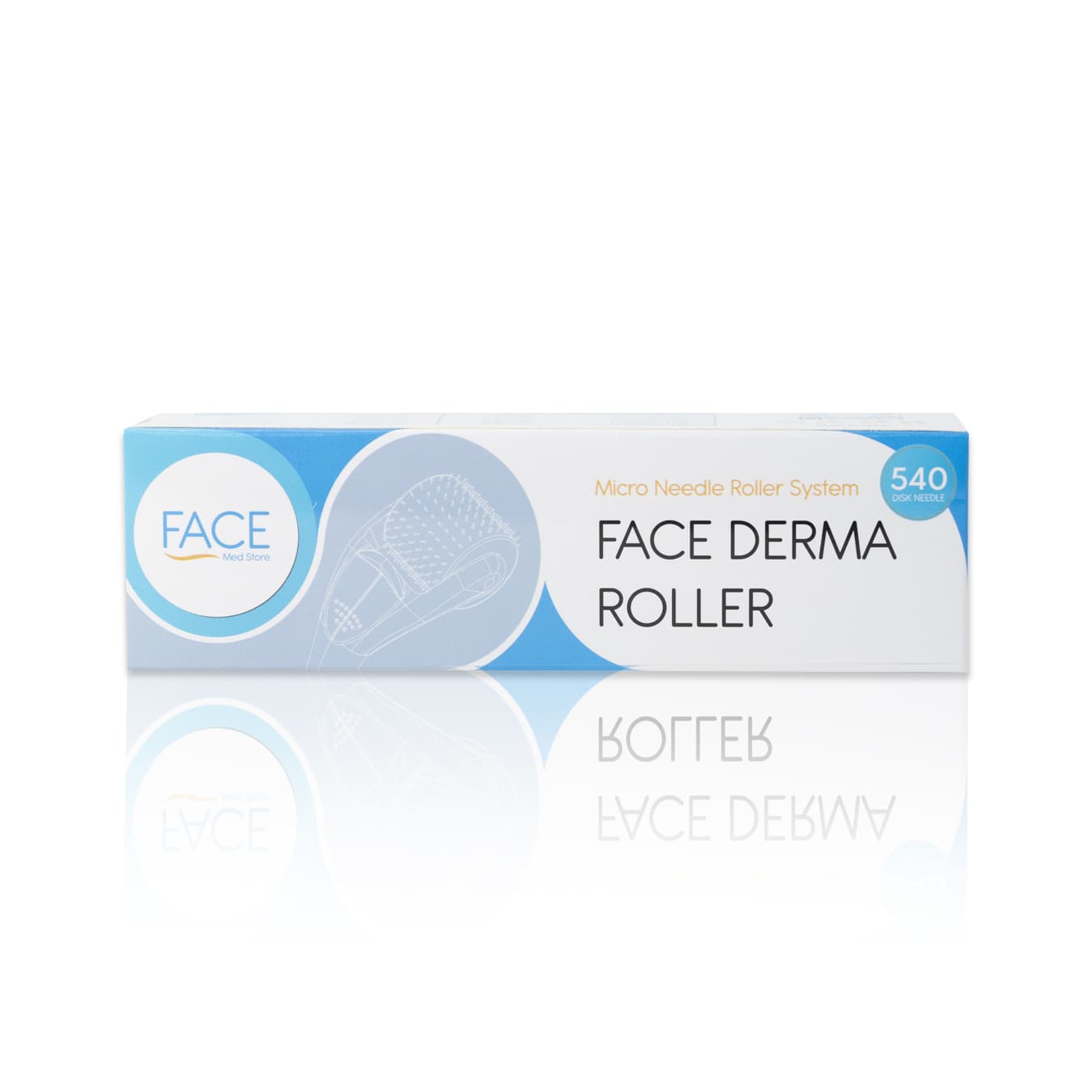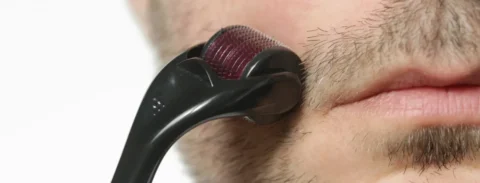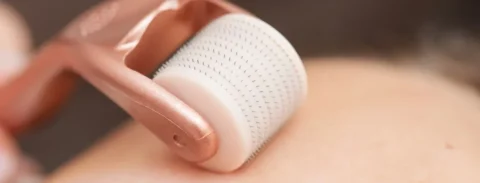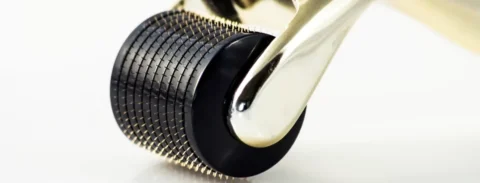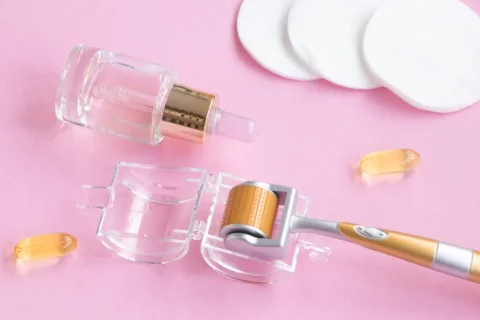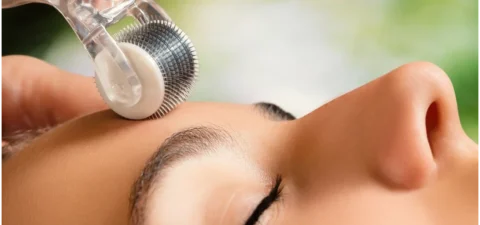Have you considered trying derma rollers to reduce signs of aging and improve the appearance of scars or stretch marks? Like many who are new to at-home microneedling, you may be wondering: do derma rollers hurt?
It’s normal to feel some apprehension about rolling tiny needles over your delicate facial skin. The good news is that discomfort levels vary quite a bit based on the microneedling device and technique used. With proper use and care, derma rolling is usually not intensely painful.
We’ll dive into how derma rollers work, their skin benefits, and what to expect for pain levels. You’ll get nifty tips to minimize discomfort, learn optimal needle lengths, and how to safely add this rejuvenating technique to your routine.
What Are Derma Rollers and How Do They Work?
Derma rollers, also called microneedling rollers or collagen induction therapy (CIT) rollers, are handheld devices covered with hundreds of tiny needles.
The small needles make tiny punctures in the outer layer of the skin, triggering the body’s innate healing response. This kicks off collagen and elastin production and creates new skin cells, blood vessels, and tissue.
During a derma rolling session, you roll the device over clean skin, typically on the face, in different directions. Many microneedling fans do it at home, while others prefer professional in-office microneedling performed by an esthetician or dermatologist using higher quality, more intensive rollers.
Microneedling can be used to:
- Reduce the appearance of fine lines, wrinkles, and crow’s feet
- Minimize acne scars, surgical scars, and stretch marks
- Fade hyperpigmentation and age spots
- Shrink appearance of enlarged pores
- Even out rough skin texture
When evaluating do derma rollers hurt and by how much, needle length is the most important factor. Rollers come in needle sizes ranging from 0.25mm to as long as 3mm. The thinner the needle, the less discomfort you’ll feel.
For example, a 0.5mm derma roller won’t penetrate very deeply into the dermis. This makes it ideal for sensitive areas like around the eyes. A 1mm roller can moderately penetrate the dermis, producing more dramatic collagen induction. Rollers 1.5mm or higher should only be used by professionals.
Results from at-home derma rolling are gradual and you may need to use it consistently for several weeks or months to see improvements.
Now that you understand the microneedling process, let’s look at the many skin benefits these handy devices offer.
What Are the Benefits of Derma Rollers for Your Skin?
Microneedling has gained a huge following with beauty influencers, skin experts, and dermatologists for its impressive skin rejuvenating abilities. Consistent use of a derma roller can lead to:
- Increased collagen and elastin production. Collagen provides structural support in the dermis to smooth fine lines and improve elasticity.
- Thicker, firmer skin with enhanced texture. Microneedles create micro-channels for better absorption of skincare products.
- Brightening of skin tone and reduction in hyperpigmentation. The gentle skin injury triggers the regeneration of new, healthy skin cells.
- Minimizing acne scars. Microneedling breaks up scar tissue and stimulates the remodeling of scar collagen.
- Softening the appearance of stretch marks. Inducing elastin and collagen remodels the skin to gradually improve indented streaks.
- More even skin tone overall. The process also stimulates other proteins, like keratin, for brighter radiance.
Additionally, there is very minimal downtime associated with at-home microneedling. Results accumulate gradually with consistent use. Just be sure to give your skin adequate recovery time between sessions. Consult your dermatologist if you have concerns about scarring or other reactions.
Now that you know the multitude of anti-aging, rejuvenating perks derma rollers offer, let’s get into the pressing question at hand: how much does the microneedling process actually hurt?
What Does the Derma Rolling Experience Feel Like?
The level of pain or discomfort caused by at-home derma rolling varies based on several factors:
| Factor | Description |
| Needle Length | The tiny 0.25mm needles likely won’t cause much pain. 1mm needles penetrate deeper to induce more collagen. |
| Needle Quality | Dull needles elicit more dragging and pinching versus sharp, high-grade needles. |
| Pressure Used | Light pressure minimizes any stinging sensation. Let the device do the work. |
| Skin Firmness | Thinner, weaker skin on the neck or chest may be more sensitive. |
| Location | Sensitive areas like around the eyes, lips, and nostrils feel more intense. |
| Skin Conditions | Inflammation or active acne can heighten discomfort. |
| Tolerance for Pain | Some have naturally higher pain thresholds than others. |
Many derma roller fans compare the sensation to light pinpricks or the tingling feeling of facial peel treatment. It causes a mild inflammatory response in the skin, which is why some redness, sensitivity, or irritation occurs.
During the session, you’ll roll across each area of skin 4 to 6 times vertically, horizontally, and diagonally. With each pass of the device, you may feel some mild stinging or burning. Right after microneedling, the skin may look slightly red and swollen. It may feel warm, tight, or sensitive to the touch.
These reactions are totally normal and subside within a few hours as the skin calms down. To minimize discomfort, use a quality roller with sharp, smooth needles of the optimal size for your skin. Apply gently yet consistently on properly prepped and numbed skin.
Next, let’s look at tips and techniques for making derma rolling as painless as possible.
How to Minimize Discomfort During At-Home Microneedling
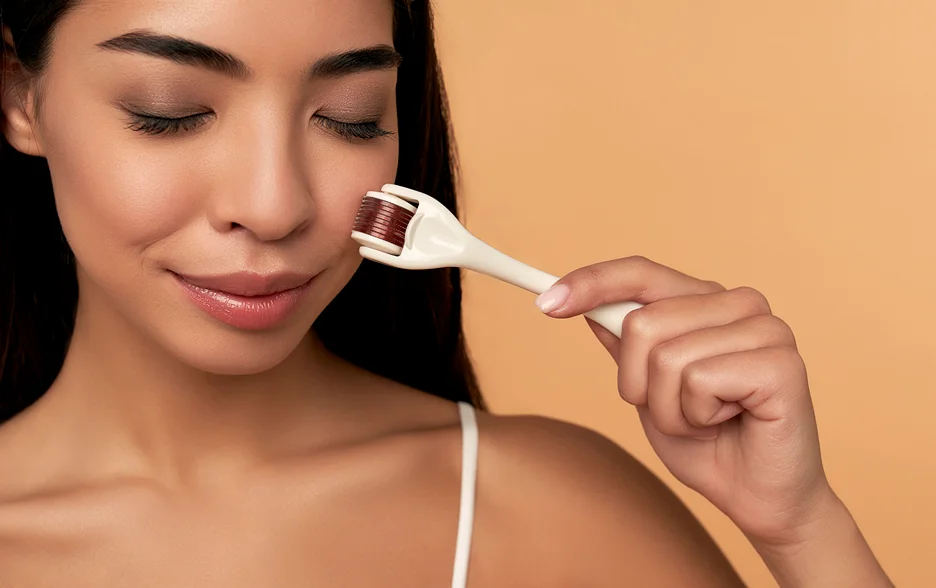
While everyone’s pain tolerance differs, you can take steps to reduce uncomfortable prickling, stinging, pinching, or burning sensations during your derma rolling session:
- Start with smaller needle sizes like 0.25mm or 0.5mm to allow your skin to acclimate if new to microneedling. Only increase needle length gradually as your skin adjusts.
- Apply a numbing cream like lidocaine for 30 minutes beforehand to diminish discomfort. The numbing effects wear off after about 15-30 minutes, so roll promptly once they kick in.
- Help the topical anesthetic penetrate by placing a hot towel over your face after application. Just don’t burn yourself.
- Take an over-the-counter pain medication like acetaminophen an hour before to curb sensitivity.
- Prep the skin with calming, soothing products a few days prior to minimize reactivity. Avoid abrasive acids or scrubs right before.
- Apply very gentle pressure and roll slowly. There’s no need to roll vigorously or quickly. Let the device do the work.
- Use a high-quality derma roller with smooth, surgical steel or titanium needles to prevent dragging, tugging, and pinching.
- Apply hydrating, nourishing serums immediately after to calm, cool, and replenish the skin. Avoid anything drying, harsh, or irritating.
- Cleanse skin gently and avoid very hot showers for 24-48 hours post-treatment while the microchannels heal.
- Allow several days between microneedling sessions for proper healing and to avoid over-exfoliation.
With the right expectations, numbing preparations, and appropriate aftercare, derma rolling should not feel intolerably painful. You may feel some mild to moderate discomfort as the needles stimulate collagen metabolism and the healing factors kick in. But the results are worth it!
Next, let’s look at how to select the optimal roller size and frequency of use for your unique skin goals and sensitivity.
Choosing the Ideal Needle Length for Your Skin
One of the biggest factors in how much derma rolling hurts comes down to needle length. This determines how deeply the microneedles penetrate into the dermis to induce collagen and elastin.
According to the FDA, rollers with needles up to 0.3mm are approved for unsupervised at-home use. Longer needles above 0.5mm should only be used on the face by beginners under professional supervision, as incorrect use risks skin damage.
Here are some general guidelines based on skin type and condition:
| Skin Type | Recommended Needle Length |
| Acne-prone or oily skin | 0.5mm provides mild exfoliation without over-drying. |
| Sensitive or thin skin | 0.2-0.3mm minimally penetrates to avoid excess irritation. |
| Stubborn wrinkles and scars | 00.5-1.5mm moderately penetrates to boost collagen. |
| Dull, lackluster skin | Start with 0.25-0.5mm as an initial conservative approach before increasing needle length if needed. |
| Photodamaged, aged skin | 0.5-1.5mm needles reach deeper layers to improve tone, texture, and elasticity. |
| Harder to reach spots like eyes, lips, and neck | A 00.2-0.3mm roller is gentle enough for delicate areas. |
It’s best to start conservatively with a 0.25mm or 0.5mm roller if you are new to microneedling.
How Often Can You Use a Derma Roller for Best Results?
When first incorporating derma rolling into your skincare routine, start conservatively. Use your roller just once every 2-4 weeks to allow proper healing time.
Follow these recommended guidelines for how often you need to use rollers:
| Needle Length | Recommended Frequency of Use | Benefits |
| 0.25 mm | 2-3 times per week | Helps product absorption |
| 0.5 mm | 1-2 times per week | Good for minor skin imperfections, anti-aging |
| 0.75-1.0 mm | Every 4-6 weeks or monthly | Effective for acne scars, wrinkles, skin texture |
| 1.5 mm | Every 6-8 weeks | Best for stretch marks, sagging skin, deeper scars |
Avoid the temptation to overdo it! Closely follow the manufacturer’s instructions for your particular derma roller. Allowing adequate recovery time between sessions prevents skin irritation and side effects.
Pay attention to how your skin looks and feels after each use. If you notice increased redness, dryness, peeling, breakouts, or sensitivity, you’re likely microneedling too often. Reduce frequency and needle size if this occurs.
Just be patient, as dramatic results take 2-3 months of cumulative collagen stimulation. Combining with skin-boosting serums enhances the benefits.
Now that you know what to expect pain-wise and how to minimize discomfort, let’s look at some final tips for safe, effective use of your at-home derma roller.
Best Practices for Safe and Hygienic Derma Rolling
While derma rollers provide amazing DIY facial rejuvenation, misuse risks skin damage, infection, and complications. To avoid adverse reactions, be sure to:
- Disinfect your roller before and after each use with 70% isopropyl alcohol.
- Replace rollers after 10-15 uses as needles dull. Dull needles cause more pain and damage.
- Avoid rolling over active breakouts, cuts, eczema, rosacea, psoriasis, or sunburned skin.
- Apply a broad-spectrum sunscreen afterward, as micro-channels make your skin more UV-sensitive.
- Cleanse the face only with gentle, non-irritating cleansers post-treatment.
- Store your roller in a clean, dry, sealed case to prevent needle damage.
Carefully following usage guidelines and avoiding overuse helps prevent derma roller side effects like:
- Infection – Unhygienic rollers can cause bacterial, viral, and fungal infections.
- Scarring – Overly aggressive rolling causes micro-tears that risk permanent scarring.
- Hyperpigmentation – Repeated inflammation can darken pigment in the skin.
- Broken capillaries – Excess pressure causes delicate capillaries to break under the skin.
By now you should have a good grasp on what derma rollers are, how they benefit your skin, what to expect pain-wise, and how to use them properly. Let’s recap the key takeaways:
- Derma rollers utilize tiny needles to create micro-injuries that stimulate collagen, elastin, and healthy tissue regeneration.
- Benefits include reduction of scars, wrinkles, and pigmentation; increased absorption of skincare products.
- Discomfort ranges from mild tingling to more intense prickling depending on needle length and pain tolerance.
- Start with smaller needle sizes 0.25-0.5mm and numbing cream to minimize discomfort if new to microneedling.
- Allow adequate healing time between sessions and gradually increase needle length based on the skin’s adjustment.
- Proper sanitization, replacement, storage, and gentle technique prevent adverse effects.
- Patience and consistency lead to naturally rejuvenated, youthful-looking skin over time!
- Use hyaluronic acid or hydrating serums after rolling to assist skin recovery.
- Consult a dermatologist before use if you have any skin conditions or are on medications like Accutane.
Derma rolling doesn’t have to be a scary, painful prospect with the right expectations and approach. Incorporate it slowly into your routine and enjoy the smoothing, and brightening benefits it offers.
Enhance Your Skincare Routine with Face Med Store’s Derma Roller Offerings

Eager to explore the benefits of microneedling? Consider trying a Derma Roller plus HA. It’s a tool designed with your skin’s overall health in mind.
Feel free to visit our store to learn more about how this derma roller could fit into your skincare routine. Take charge of your skin health today—because you deserve to feel confident in your skin.
